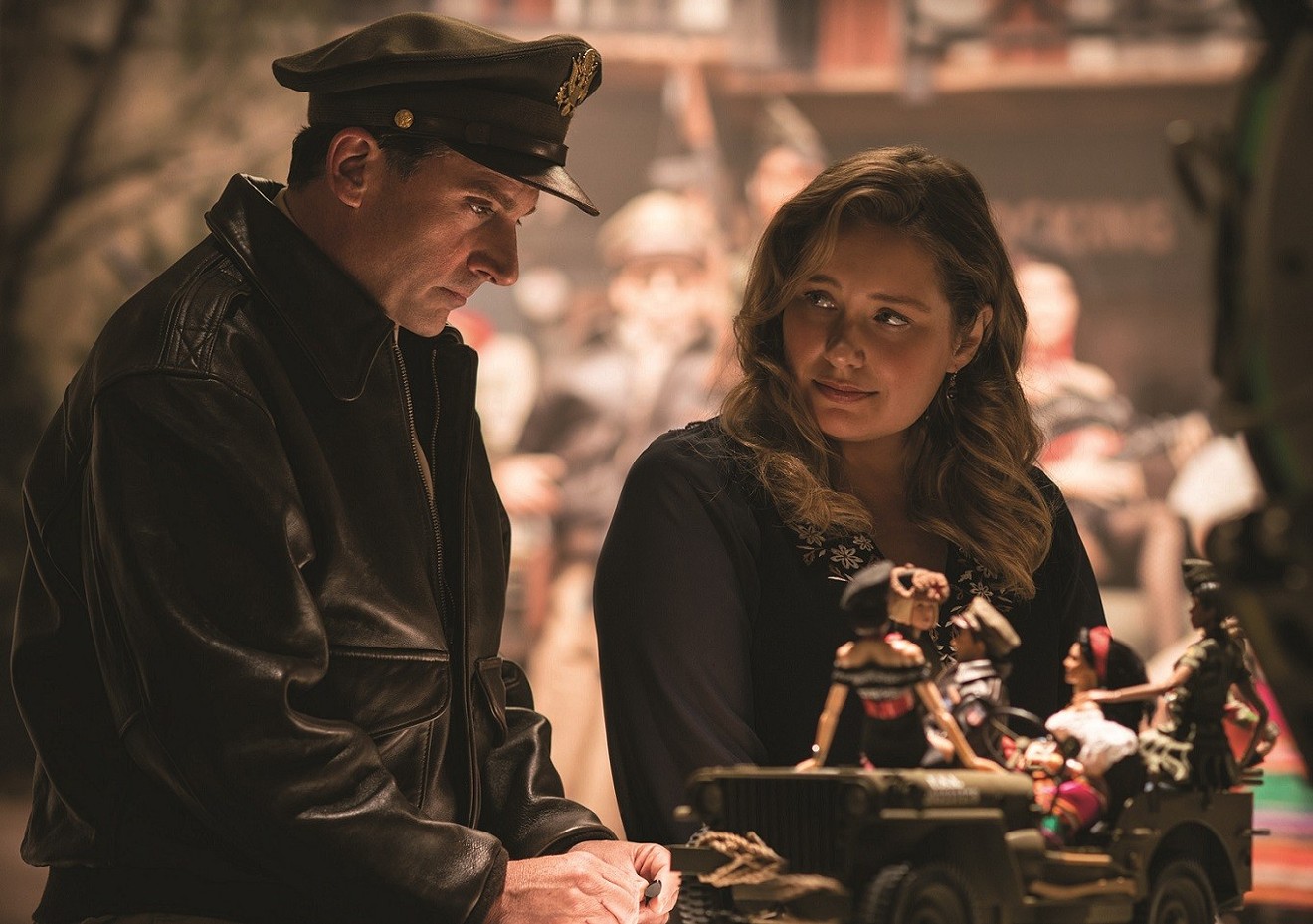Robert Zemeckis’ Welcome to Marwen is far from the family holiday hit its advertising suggests. Zemeckis — the director of Forrest Gump, Cast Away, Who Framed Roger Rabbit, the Back to the Future films and so much more, including 2016’s undervalued World War II thriller Allied — has come up with something like auteurist play therapy. It’s a big-budget film of dazzling technique and style that mashes the backyard adventures of G.I. Joes and Barbies up against scenes of harrowing addiction drama and the challenges of overcoming trauma. At times, as it dissolves between scenes of its cast as literal toy dolls machine-gunning Nazis in the made-up Belgian town of Marwen, Zemeckis’ movie seems an inquisition into the limits of the director’s own imagination. It's as if he’s worrying over the way that boomer film-brats like Steven Spielberg, George Lucas and himself have so often tried to examine urgent personal concerns within the context of violence-glorifying blockbuster adventures.
Zemeckis’ official inspiration is Mark Hogancamp, a Kingston, New York, man who began shooting impressive, uncanny photographs of dolls — OK, “action figures” — in war and love in his yard after suffering a brutal attack from teenagers in a bar. The attack, prompted by Hogancamp’s predilection for wearing women’s shoes, “kicked every memory” out of his head. Zemeckis’ film isn’t quite clear on this next point, but Jeff Malmberg’s superb 2010 documentary Marwencol is: Hogancamp spent time in a coma, then had to relearn how to eat and walk and even simply be Mark Hogancamp. He reports in the doc asking acquaintances whether he had been a nice guy.
An artist who had lost the ability to draw, Hogancamp built, during his recovery, the tiny town of Marwen behind his home and populated it with sexy-tough Barbies and other female dolls, most of whom he altered to suggest a resemblance to women in his life. There he acted out and photographed his fantasies: A square-jawed, two-fisted war-hero dude based on him crashed his plane into the town, where the SS had killed all of the men. As the documentary and his photos recount, this alt-Hogancamp opened a bar there, fighting off the Nazis and enlisting those beauties into catfighting for the amusement of out-of-town dudes. Sometimes, he shot photos of the dolls making out; sometimes, when the stories needed a kick or a woman in real life had annoyed or disappointed him, Hogancamp would imagine that the Nazis had murdered one of Marwen’s women.
That’s fertile territory for Zemeckis. After all, the real Hogancamp managed to stir human feeling with his photos of plastic toys right around the time that Zemeckis was struggling to do the same with his motion-capture horror show The Polar Express and its generally better follow-ups, Beowulf and A Christmas Carol. And as for the women-as-dolls routine, well, this is the director who put Jessica Rabbit onscreen.
Always clever, and enchanted by technological experimentation, Zemeckis stages the sequences set inside Marwen (and inside Hogancamp’s imagination) as complex, even unsettling mixtures of live action and animation. Steve Carell plays the middle-aged Hogancamp as a shy schlub, but we first meet him as Hoagie, his action-figure alter ego, landing near Marwen and teaming up with his bevy of machine-gun beauties to kill Nazis. These scenes are a mo-cap breakthrough: We’re clearly watching the real Carell, his eyes and his features and his choices as an actor, but his chin has been widened, his arms are segmented, his flesh rosily plasticized. The same goes for the women, whose Barbie proportions and pore-less faces simultaneously indulge and satirize the male gaze. Carell’s Hogancamp, of course, can’t resist exposing the nippleless breasts of his women as he acts out his imaginary scenes.
That’s funny, and Zemeckis’ film often suggests that its own creator is concerned about the kinds of roles women get in an industry still ruled by stories of men’s adventures. But actually giving women roles worth playing would be more effective than this parody. Fans eager to behold the radiance of, say, Janelle Monae should be warned: Welcome to Marwen only offers about 10 seconds where we can see the flesh of her actual face. Merritt Wever and Leslie Mann play real-life women who either have crushes on Hogancamp or are crushed on by him, and I’m sorry to say that despite both performers’ skill, neither gets to play a single convincing scene. That’s because, in the role of Hogancamp, Carell sinks into depressed Rain Man mode, working that Robin Williams trick of showing he’s serious by shutting almost entirely down, shutting everyone else out, each emotion his character feels coming out as hard and slow as a kidney stone.
The documentary Marwencol reveals Hogancamp as a man happy to talk about his storytelling and photography — and aware of that work as therapy, even if he’s often so caught up in it that you worry he might lose sight of what’s real and what’s not. Carell’s Hogancamp is quieter, more naifish, a Gumpian eccentric rather than a chatty, imaginative dude working his way through a tragedy. The real Hogancamp’s photos are singular, mysterious, upsetting, oddly beautiful, outsider art expressive of something vital inside the artist. What he captured in his backyard for nickels is much more arresting than Zemeckis’ million-dollar action scenes, which become increasingly tiresome Hollywood productions, full of pyrotechnics and stale action beats.
The filmmakers attempt to map elements from Hogancamp’s life — an addiction, that assault — onto the World War II action, but ultimately all the dolls’ tough talk, bad puns, sexless flirting and hails of bullets play as just more of the blockbuster same (brace yourself for several Ready Player One-style Back to the Future callbacks) rather than any kind of inquiry into Hogancamp’s psyche. At its worst, Zemeckis’ Marwen isn’t an exploration of the limits of the imaginations of Zemeckis’ generation of moviemakers — it’s an example of it.
[
{
"name": "Air - MediumRectangle - Inline Content - Mobile Display Size",
"component": "18855504",
"insertPoint": "2",
"requiredCountToDisplay": "2"
},{
"name": "Editor Picks",
"component": "17105533",
"insertPoint": "4",
"requiredCountToDisplay": "1"
},{
"name": "Inline Links",
"component": "18349797",
"insertPoint": "8th",
"startingPoint": 8,
"requiredCountToDisplay": "7",
"maxInsertions": 25
},{
"name": "Air - MediumRectangle - Combo - Inline Content",
"component": "17105532",
"insertPoint": "8th",
"startingPoint": 8,
"requiredCountToDisplay": "7",
"maxInsertions": 25
},{
"name": "Inline Links",
"component": "18349797",
"insertPoint": "8th",
"startingPoint": 12,
"requiredCountToDisplay": "11",
"maxInsertions": 25
},{
"name": "Air - Leaderboard Tower - Combo - Inline Content",
"component": "17105535",
"insertPoint": "8th",
"startingPoint": 12,
"requiredCountToDisplay": "11",
"maxInsertions": 25
}
]












